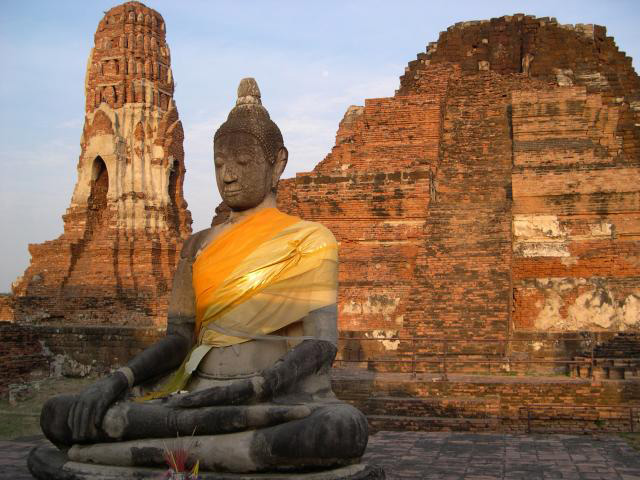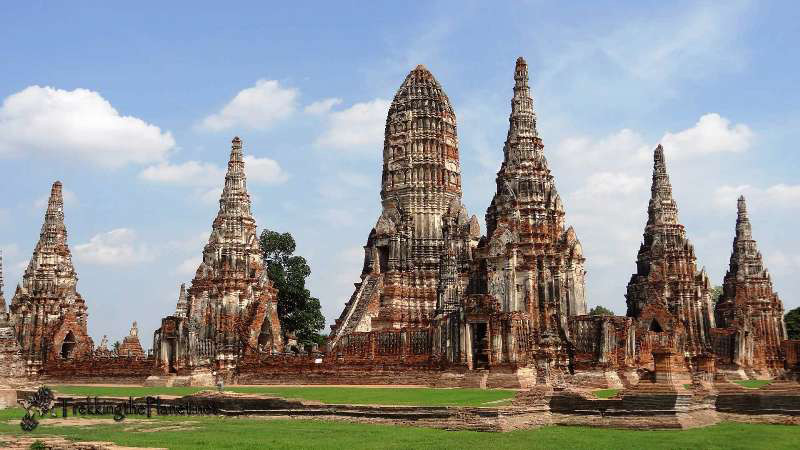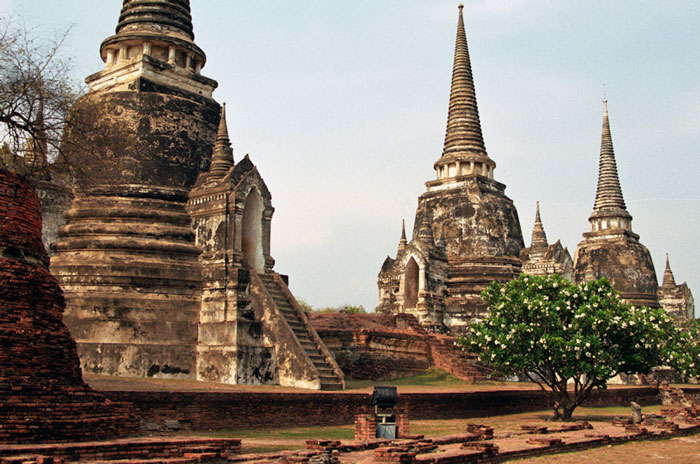Ayutthaya historical city
The United Nations Scientific, Educational and Cultural Organization (Unesco) has recognized Thailand's historic city of Ayutthaya as a World Cultural Heritage in 1991.
Located 76km north of Bangkok, the historic city of Ayutthaya stretches over a large area to over 289ha. This is truly a great city and one of the most attractive historical sites in Thailand. At the same time, the historical city of Ayutthaya is also one of the most attractive cultural heritages in Thailand because of the splendor of four centuries of history that remain through hundreds of architectural works, mainly built by Red burned bricks.

Ayutthaya was recognized as a world cultural heritage by Unesco in December 1991. The splendor of the ancient city is reflected in many magnificent monuments and ruins, most of which are built. Red brick ceiling, located all over a land surrounded by three rivers of Chao Praya, Mae Nam Lop Buri and Pa Sak. Perhaps so, Ayutthaya is enshrined in many tourist memories as an oasis of riverside temples.

Thai history is divided into phases: Sukhothai (1238-1438), Ayutthaya - absorbs the essence of Sukhothai culture and flourishes in the history of more than 400 years from 1350-1767, Thon Bori ( 1767-1782) and Rattanakosin (1782 up to now). The ancient city of Ayutthaya, also known as Pra Nakhon Si Ayutthaya, was once the capital of Thailand for 417 years.

The ancient citadel was built in 1350 by U-king , captured by the Burma army and destroyed in 1767, ending the Ayutthaya period. There were 33 kings replacing each other, and building Ayutthaya into a brilliant capital in the past. Ayutthaya once had a very developed agriculture and prosperous trading relationships with Eastern and Western countries.

During the period, the dynasty always resisted aggression from neighboring countries, especially Burma . In 1758, the country was disturbed by a rivalry for the royal throne, resulting in a disastrous defeat in the war with the Burmese in 1767. Burma army when invading the capital ordered the burning. burning and destroying many magnificent and magnificent buildings of the Ayutthaya dynasty. The remains of the ancient citadel have formed the present-day Ayutthaya historical park.

The complex of monuments is quite diverse, and is relatively intact as the monastery of Wat Phra Chao Phya-thai lies on the southeast side of the citadel. From the city you can see the great monastery of the monastery built in 1357 for returning monks from Sri Lanka. In 1592, a large temple built here with this huge architectural idea will commensurate with the large temple of Wat Pukhao Thong (built in the previous Sukhothai era). The architectural complex Wat Yai Chaimongkhon consists of monasteries, pyramids and temples, including the largest tower tomb and two giant Buddha statues by the hundreds of years old tree.

In the relic area, there are many groups of temples and towers , each symbolizing a small universe with a sacred mountain in the center of "the axis of the universe" , the symbolic walls that limit the infinite universe and the ocean. . The largest tower in the monument complex is up to 35m high, four sides have a steep staircase leading to the top. From the corridor running around the largest tower of tombs, a large space of sunshine will be observed to the horizon and the entire ancient city. Eight smaller towers are located in four square corners and four quadrilateral corners are connected by long hallways, along the hallways, 120 Buddha statues with posture and posture. Most sandstone statues lost their heads due to destruction during the war with Myanmar in the mid-eighteenth century. Seeing and stopping to take photos at these statues is a very impressive moment, saving the faint emotion for many visitors.

The Ayutthaya capital is also the "city of ruins " because hundreds of collapsed walls, towers, and temples are only partially destroyed or have their foundation . all preserved carefully. . Some architectures are somewhat restored with new materials but do not cause offense because they are carefully restored to every detail. A number of other temples were restored almost entirely, including giant Buddha statues. But all are strangely harmonious with each other and with the surrounding natural landscape. It is known that restoration work has been carried out for decades, generations of scientists have patiently rediscovered little by little what time has taken.

Ayutthaya is also considered a cultural heritage park by the green of ancient trees and smooth grass alternating between architectural ruins, fresh air, quiet, from the streets to very relics. clean. Ayutthaya is also known as an oasis of temples on the Chaophraya river.

Today, the historic city of Ayutthaya is one of the most attractive tourist destinations in Thailand, people come here not only to visit a cultural heritage but also to seek Buddhism and fiber. the cord that connects the present and the past, and to find peace and quiet in the soul.
- 5 famous historical places are haunted
- Historical relics in the ancient city of Mtskheta
- 11 famous historical events thought to be real but were fictional
- 25 extremely rare historical photos you've never seen
- Surprised with rare historical series hard to find
- Laser map the ancient city in Jordan
- 15 impressive historical moments
- 4 historical facts that many of us don't know about
- Dubai-City is the most luxurious city in the world now and 60 years ago
- Krakow - The ancient capital of Poland
- More than 2,000 bodies landed on the Japanese coast
- Time's most influential photos of all time
 Suzhou classic bonsai garden - China
Suzhou classic bonsai garden - China Chau Nguyen Dynasty
Chau Nguyen Dynasty Thai Son Mountain - World Wonder
Thai Son Mountain - World Wonder Ancient villages of Shirakawa-go and Gokayama
Ancient villages of Shirakawa-go and Gokayama Sukhothai historic city
Sukhothai historic city  Vladimir monuments
Vladimir monuments  Indian Mahabalipuram architectural complex
Indian Mahabalipuram architectural complex  Chitwan National Park - Nepal
Chitwan National Park - Nepal  Sun Temple Konark, Orissa - India
Sun Temple Konark, Orissa - India  Great mosque and Divrigi Hospital - Turkey
Great mosque and Divrigi Hospital - Turkey 